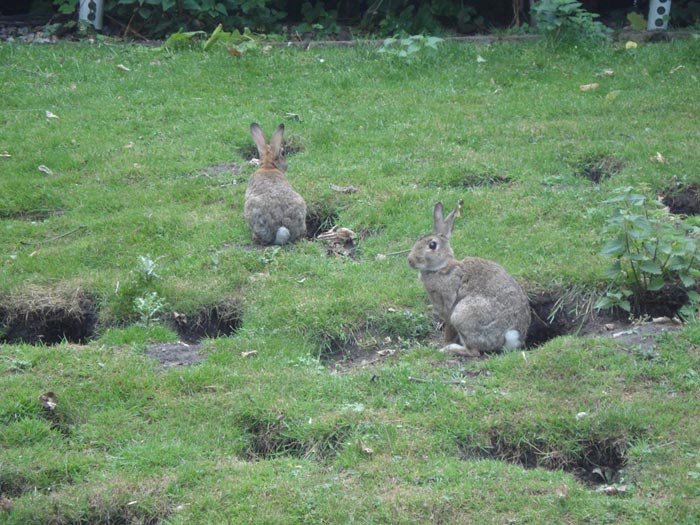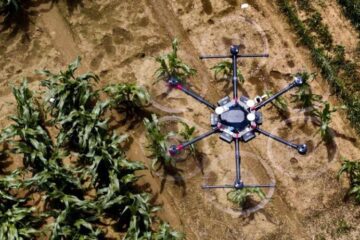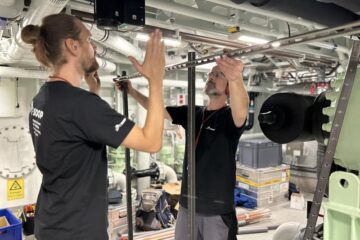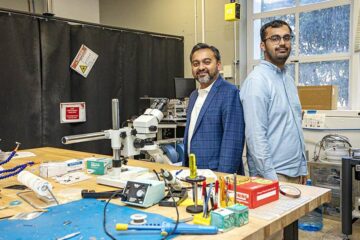In the city, rabbits build more densely

European wild rabbits Oryctolagus cuniculus in the inner city of Frankfurt. Information: Madlen Ziege, Institute for Ecology, Evolution and Diversity, Campus Riedberg, tel.: 015773883101, madlen.ziege@googlemail.com.
European wild rabbits (Oryctolagus cuniculus) not only achieve high population densities in the city, their burrows are also built more densely and on a smaller external scale. That is something researchers in the Goethe University's Task Force on Ecology and Evolution have discovered in their study on wild rabbit populations in and around Frankfurt.
As they report in the advance version of the Journal of Zoology, small burrow structures with fewer entrances and exits predominate in Frankfurt's inner city. These structures are inhabited by few animals – often only pairs or single wild rabbits. In contrast to this, the structural systems in the rural environs of Frankfurt are substantially larger and are also inhabited by larger social rabbit groups.
“The optimal habitat for a wild rabbit offers both, access to sufficient nourishment and the opportunity to establish rabbit burrows in very close proximity, or to seek out protective vegetation” explains doctoral candidate Madlen Ziege, a member of Prof. Bruno Streit's team. In rural, often agricultural used areas, with their cleared and open landscapes, these conditions are getting harder to find. Apparently, urban and suburban habitats satisfy the needs of wild rabbits far better.
In view of the fact that in some cities there is already talk of a “rabbit infestation”, while in recent years the rabbit population in many rural areas of Germany has declined significantly, the scientists currently want to determine whether in the future urban populations could play a significant role as the source populations for the preservation of this wild animal species in Germany. They are therefore examining the population genetics or dynamics, their use of habitat and the state of health of rural, urban and suburban wild rabbit populations.
Link to the publication: http://onlinelibrary.wiley.com/doi/10.1111/jzo.12207/abstract;jsessionid=01D094D…
You can find an image for the download at: www.uni-frankfurt.de/53984081
Caption: European wild rabbits Oryctolagus cuniculus in the inner city of Frankfurt.
Information: Madlen Ziege, Institute for Ecology, Evolution and Diversity, Campus Riedberg, tel.: 015773883101, madlen.ziege@googlemail.com.
Goethe University is a research-oriented university in the European financial centre Frankfurt Founded in 1914 with purely private funds by liberally-oriented Frankfurt citizens, it is dedicated to research and education under the motto “Science for Society” and to this day continues to function as a “citizens’ university”. Many of the early benefactors were Jewish. Over the past 100 years, Goethe University has done pioneering work in the social and sociological sciences, chemistry, quantum physics, brain research and labour law. It gained a unique level of autonomy on 1 January 2008 by returning to its historic roots as a privately funded university. Today, it is among the top ten in external funding and among the top three largest universities in Germany, with three clusters of excellence in medicine, life sciences and the humanities.
Publisher: The President of Goethe University, Marketing and Communications Department, 60629 Frankfurt am Main
Editor: Dr. Anne Hardy, Officer for Science Communication, Tel: +49(0)69 798-12498, Fax +49(0)69 798-761 12531, sauter@pvw.uni-frankfurt.de
Internet: www.uni-frankfurt.de
Media Contact
All latest news from the category: Ecology, The Environment and Conservation
This complex theme deals primarily with interactions between organisms and the environmental factors that impact them, but to a greater extent between individual inanimate environmental factors.
innovations-report offers informative reports and articles on topics such as climate protection, landscape conservation, ecological systems, wildlife and nature parks and ecosystem efficiency and balance.
Newest articles

AI to Make Crop Production More Sustainable
Drones monitoring fields for weeds and robots targeting and treating crop diseases may sound like science fiction but is actually happening already, at least on some experimental farms. Researchers from…

Cruise Ship as Data Collector
New Approaches in Ocean Observation… Scientific research – not only confined to dedicated research vessels but also from non-scientific vessels and marine infrastructures. This is one of the ideas promoted…

Groundbreaking microcapacitors could power chips of the future
Scientists developed microcapacitors with ultrahigh energy and power density, paving the way for on-chip energy storage in electronic devices. In the ongoing quest to make electronic devices ever smaller and…





















